So you want to make an A/D map, preferably featuring 3 stages. But what do you need to consider to make sure Blu don't steamroll or Red from forming an impenetrable bulwark? How about this...
People tend to overcomplicate matters for their A/D maps; indecisive area sizes and inappropriately lengthy corridors, ill thought out secondary paths and a lack of understanding as to how players will respond to their environment. We consider the engine, and we consider the player.
Chapter log:
Considering the basic layout.
Considering Blu spawn.
Defining an alternative route.
Balancing alternative routes.
Progressive difficulty.
Making your map unique whilst following this template.
Final thoughts, the engineer and the sniper.
Additional information.
The long winding road.
The best trend to exercise for a map that will inevitably occupy a length of space, such as A/D, is to wrap it around itself. This not only means you have less of a chance to reach your map boundaries but that you have more opportunities to increase optimisation and vary your maps gameplay aspects with bends and corners. This is also true for 5 CP push maps which regularly take on an S shape.
Goldrush.
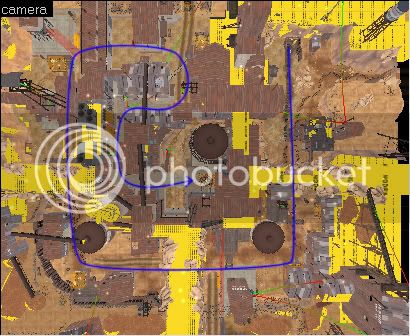
Dusbtowl.
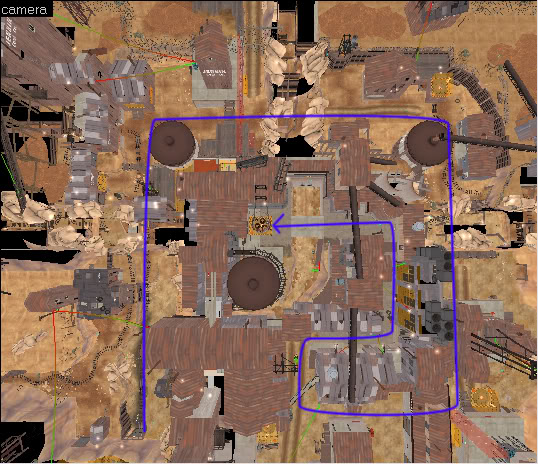
Badwaterbasin.
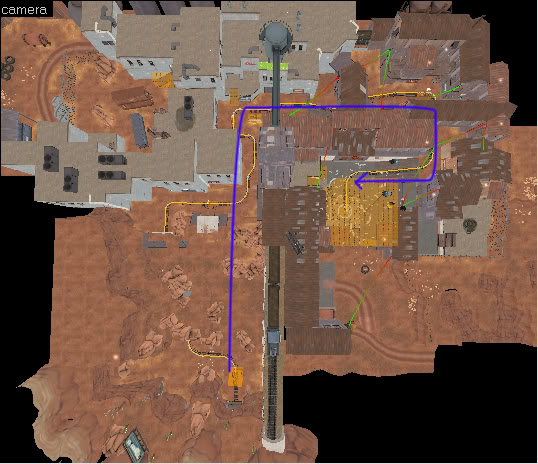
One small step for Blu.
A reasonable spawn setup from which Blu assaults Red will usually consist of either 3 minor exits, or 1 major and 1 minor exit (or similar mixture there of). This relates directly to player count and is relevant to area transitions; CP1-CP2. Firstly, a team will (at maximum) consist of 16 players. This becomes a small amount when you start to split them up into any more than 3 routes that will inevitably reach a single objective defended by up to 16 enemies at once. So to have any more than 3 seperate paths is a bad idea and breaks player focus. These spawn exits should allow players direct or at least indirect (special jumping) access to significant play area's (defined below).
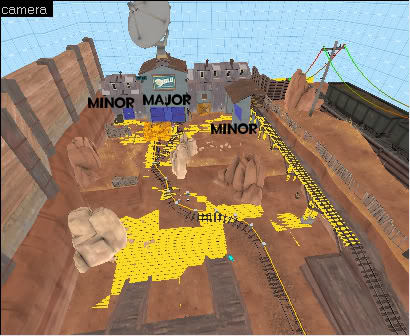
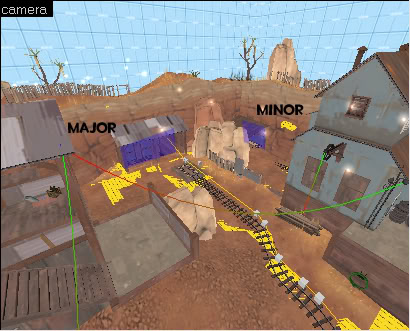

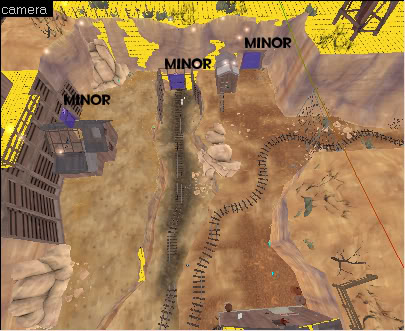
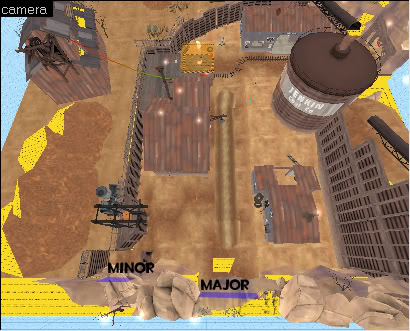
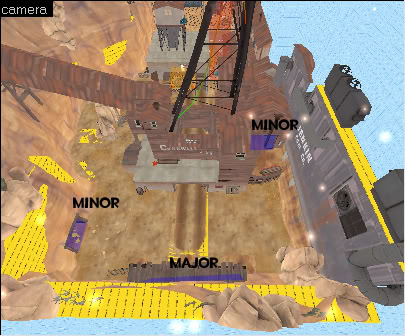
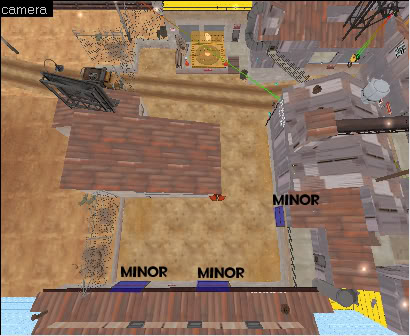
What are my options as a player?
High ground, low ground, and middle ground. These are fairly self explanatory but can exist in their own varying ways depending on the approach of the level designer. Particular routes will be favoured by particular classes and will be catered for by the level designer to compliment the obvious gameplay tactical choices any player will want to employ.
You can't defeat me now, i have the high ground!
The high ground will be favoured by the sniper where he's hard to attack and far from sight. Whilst the soldier can fire rockets into his enemy before jumping down to finish off the job and inevitably complete the map objective. They are also favoured by players whom prefer to penetrate further into enemy territory with lowered risk of being intercepted and achieving the element of surprise.
A low blow indeed!
The low ground will provide the best flanking position due to greater territory penetration. Less flak will be received from the low ground as visibility is limited which means it is more likely to be overlooked by defenders in comparison to larger and more likely threats; the high and middle ground. This route will be favoured by spy's and pyro's and other surprise player formations (a surprise ubered heavy etc).
In contrast to the standard assault mode, payload mode can contradict this trend due to the single moving objective. The objective which travels forwards along a predefined path defines the main route itself, and may occupy and subsequently redefine the higher or lower grounds as the main route. However, in the name of balance it normally occupies the middle or lower ground. So the low ground frequently becomes the main route. As illustrated below.
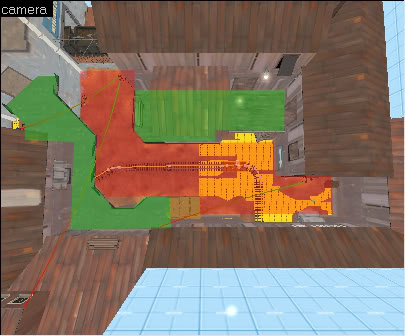
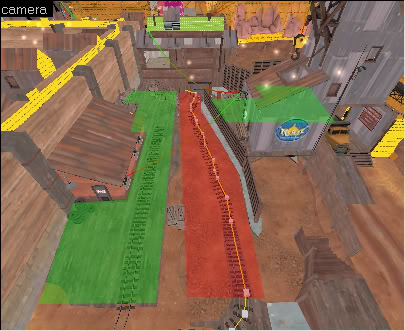
Incoming!
The middle ground is usually the main assault force direction and will likely consist of most of the available classes. These classes will pack a heavy HP punch consisting of buffed heavies, soldier's, pyro's and demo's etc. The main route/middle ground will be flanked either side by the higher ground which penetrates a moderate amount into the next territory (or merely a bay to shoot from in relative safety and even jump from), and the lower ground which will also penetrate moderately or even significantly beyond the main routes entrance to the objective.
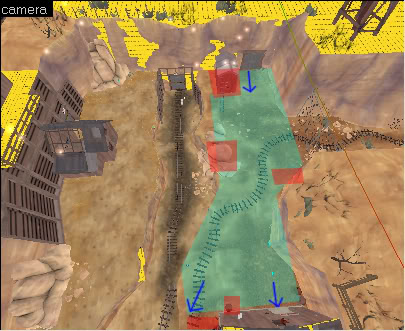
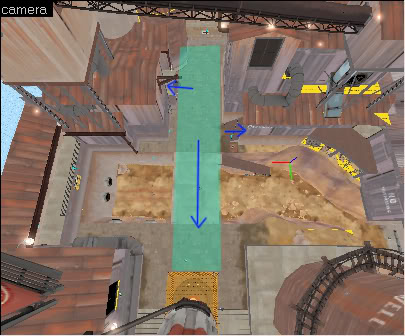
The main route should be wider to accommodate the greater congregation of players. Too small and explosives become over powered, which unbalances classes as well as teams. The main route should also include moderate cover as players will attack and counter attack frequently. Cover can come in the form of corners or detail props/brushes. The secondary routes can be smaller, fewer players will traverse these paths and less space is required; these routes are also frequently one way, so less cover is required. Also, these routes will generally branch from the previous area and reattach to the main path/objective, to create the secondary routes as large as the main route would only make things cumbersome.
These 3 categories of path need to be balanced with 3 more considerations. Short, long and medium length paths. Due to the spawn time, players will often favour the shortest path to the objective, even if it is the most dangerous (which it probably will be). Long paths can be employed to balance area's of greatest tactical advantage, whilst short paths might be frequently counter-attacked, spammed and ambushed. In general the main route will be shortest, the high ground of medium distance and the low ground usually the longest, possibly flanking the objective completely.
Progressive difficulty.
A key part of multi-stage A/D (and even single stage), is for the maps difficulty for Blu to progressively become more difficult per stage/control point. The current official maps produce this with various levels of success, but there are several options available to you to achieve this element of A/D gameplay. The easiest and simplest way to make things more difficult is to reduce the number of paths of attack to the next control point. This is a method i would leave until the finale, as its gameplay effects are powerful; early use of reduced alternate paths means its not sensible to use at later points without totally damaging overall map balance and can be seen as generally bad design if the map does not play well throughout. More imaginative ways of increasing Blu's difficulty is to not provide them with areas to regroup or gather before an objective; such an area is present on the last bend of Dustbowl and goldrush before the Finale (the long winding path between the last control points), where although large ammo packs allow Blu engineers to get a forward base setup quickly, a single Red uber or mass counter attack can flush out the Blu team. Other more internal layout choices can be applied, such as more powerful defencive positions that are purposesfully unbalanced in Red's favour. Like more numerous ledges with larger ammo and health drops. Additionally it should be noted that Red are given the use of a "spawn shortcut" to the first CP in the third and final stage of A/D maps, which is not apparent with previous stages before the finale. This is in part due to the long winding path seperating the 2 control points in the final stage and allows Red to travel to the round-gates faster. Narrower paths are also an option, as it does make Blu more vulnerable to splash damage and small scale flanking manouvres.
Defining your routes for a unique environment.
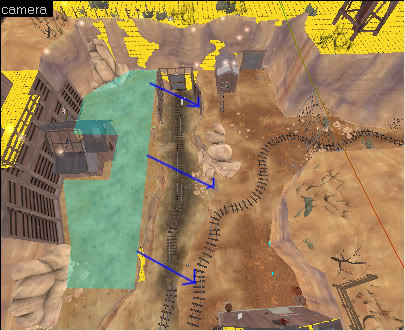
Despite the fact that there are only 2 height levels in this area (excluding stand alone structures) we can consider the left path high ground. It flanks the main path and provides a point where players can gain a greater understanding of the battlefield visually. Players may opt to take cover in the low ground from here or leap to the main route.
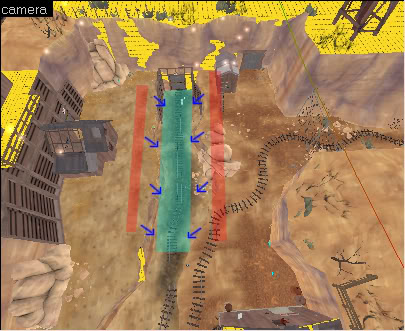
The low ground. The low ground is difficult to defend effectively without exposing more vulnerable positions more likely of attack. Limited visibility, reduced number of conflicts with attention on the entrance and exit define this low grounds key tactical features. Taking the low ground as a path to your enemy is always a gamble, handicapping your combat advantages or sacrificing time for the element of surprise.

The middle ground, or “no mans land” may exchange hands in attack and counter attack, and should provide cover and possibly height variations that benefit both teams. The final stage usually includes a winding corridor to the finale. Otherwise, the main route should be wider than the others.
Regroup!!!
So Blu have used your 3 routes effectively and taken the first CP. How does the first area bridge with the second? Trends vary, but generally consist of the main path and 2 alternates; or 2 equally significant paths (one high and one middle ground). Direct visibility from CP1 to CP2 is nil and for optimisation purposes (although it does inadvertently compliment gameplay by balancing classes). For the main route, the path will often be split into two paths and allow the player to approach the next main area from 2 directions. While the higher and lower grounds flank and penetrate even further into enemy territory.
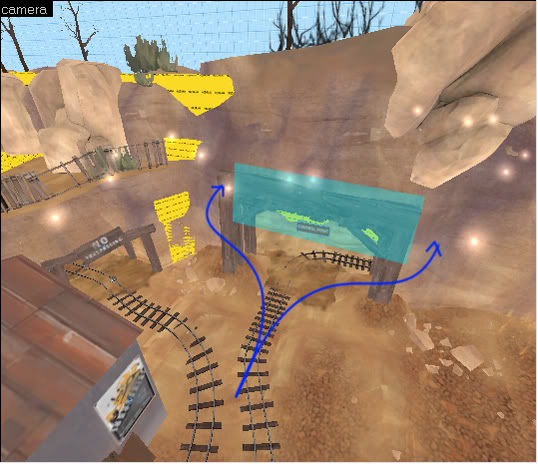
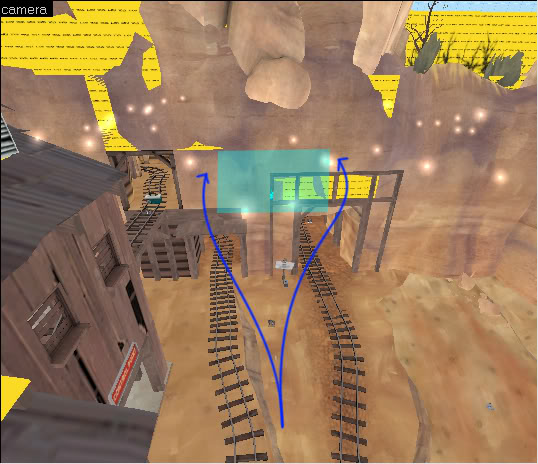
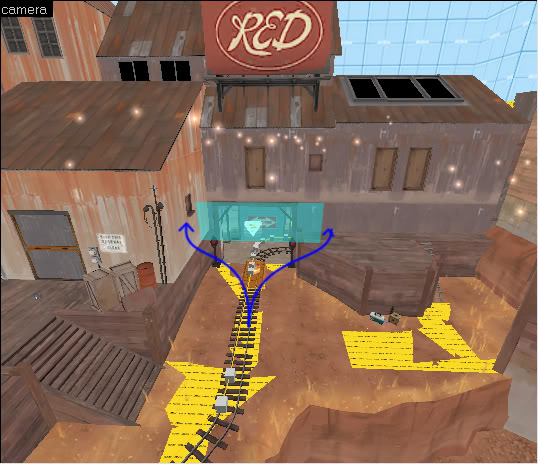
Here i have demonstrated how Valve generally seperate 2 areas visually/physically. The walls not only prevent excessive lines of sight for better gameplay, but blocks vis, increasing map performance. Textures such as chicken wire and glass when applied to solid world geometry will cause that brush to no longer block vis. They should be avoided if your map suffers from bad performance.
Mixing things up: What makes your map unique.
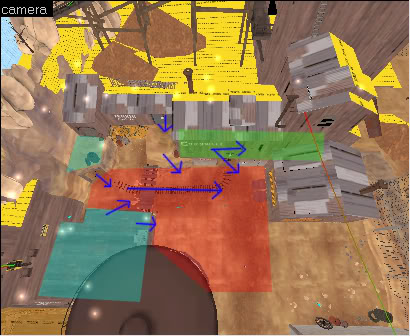
We can define the layout mechanics here quite easily, despite the complicated geometry and interlocking doors/bridges (which should generally be avoided, in order to focus combat). We can look at this areas design as a worst case scenario in terms of sophistication. The right route (from Blu's perspective) provides limited penetration via high ground. Blu already has easy access and control of the high ground on the left, so this area should not be given extra visibility or firing lines against Red, but has also been made counter-attack-able for Red through a ground route from the main path in addition to the blind corner. Red can seek to control this valuable ground. This balances the left high ground and its one way door that prevents direct counter attacks from Red. The green area can be considered the low ground due to it's limited visibility in and out, narrow route and direct path, with focus on the entrance and exit.
At the end of the day it is not a requirement that a particular area requires all of the above 3 routes to be complete. The alternate paths can exist in varying forms as long as they all balance out. 2 routes of high ground and moderate territory penetration can still equal the tactical advantage of one high route with low penetration and one low route of higher penetration. The choice of what alternate routes to use are often influenced by the available space and is not a bad reason to apply a low ground over some high ground even if that is what you intended. As a designer compromises will always have to be made, and it is not worth making things difficult. If it doesn't work, cut it out and think of this as a template to consider other possibilities.
Final thoughts: Considering the static defence.
The immediate thought that comes to mind when the majority of people consider making a custom assault style map is for Blu to be attacking a rediculous fort, with all sorts of amazing, elaborate sentry nests and sniper towers. Directly considering the role of individual classes over others generally leads to class favourable maps and imbalances.
Meet the engineer.
If a sentry spot is too powerful, but you don't want to change your layout, reduce the sizes of local ammo drops. This way it is difficult to set up a sentry gun, but if it is achieved, the engineer is rewarded with many kills. A level designer can influence sentry positions by ammo drop locations and their ammo size, along with the available cover such as corners or waist height props. If a sentry covers a large number of exits it allows the engineer to acquire many points, have it outranged somewhere or directly flanked to reduce its mortallity rate.
Meet the sniper.
We all love to consider the perfect sniper position: An area that covers a key route with a lot of player traffic. Local ammo and health supply. Cover for protection. Height and great distances to keep yourself out of reach. One path to dream location to watch your back all the more easier. If your map has a location like this then i would seriously recommend removing it. A sniper always needs to be vulnerable, as vulnerable to its anti-classes as all other classes are to the sniper behind his scope. If a sniper has great distance for protection reduce his field of vision, if it covers the main route where a sniper can acquire many points, have it flanked by an alternate route or make sure the distance and/or height advantage is severely limited. Because we all know what a sniper wants it's hard not to accomodate for it, but we still need to balance him by allowing him to be killed as much as any other class.
Summary and additional information:
3 basic routes of attack: High, low, and middle ground. As a designer you will negotiate these variables.
A stage: Spawn > arena > objective > dividing wall > arena > objective.
High ground may penetrate territory, but should not provide Blu with area control.
Low ground may penetrate territory and even flank an objective.
Approximate area of play sizes in Hammer units.
Dustbowl area sizes:
Stage1 Area1: 2432 long 1344 wide
Stage1 Area2: 1920 long 1344 wide
Stage2 Area1: 2368 long 1488 wide
Stage2 Area2: 1984 long 1536 wide
Stage3 Area1: 1792 long 1024 wide
Stage3 Area2 consists of 2 winding corridors 1408 long and 1472 long
Stage3 Finale: 1536 long 1664 wide
Goldrush area sizes:
Stage1 Area1: 2432 long 1408 wide
Stage1 Area2: 1408 long 1792 wide
Stage2 Area1: 2688 long 1664 wide
Stage2 Area2: 2176 long 1664 wide
Stage3 Area1: 2304 long 1280 wide
Stage3 Area2 consists of 2 winding corridors 2304 long and 2176 long
Stage3 Finale: 1280 long 1792 wide
Sentry sight distance: 1100 hammer units.
Disclaimer:
Please note that this is not a comprehensive guide to Attack / Defend maps, the possibilities are quite extensive. I have discussed the introduction of map limitations that focus and control gameplay in order for you to produce a map with working-complimentary gameplay for TF2, for standard 24-32 player servers.
People tend to overcomplicate matters for their A/D maps; indecisive area sizes and inappropriately lengthy corridors, ill thought out secondary paths and a lack of understanding as to how players will respond to their environment. We consider the engine, and we consider the player.
Chapter log:
Considering the basic layout.
Considering Blu spawn.
Defining an alternative route.
Balancing alternative routes.
Progressive difficulty.
Making your map unique whilst following this template.
Final thoughts, the engineer and the sniper.
Additional information.
The long winding road.
The best trend to exercise for a map that will inevitably occupy a length of space, such as A/D, is to wrap it around itself. This not only means you have less of a chance to reach your map boundaries but that you have more opportunities to increase optimisation and vary your maps gameplay aspects with bends and corners. This is also true for 5 CP push maps which regularly take on an S shape.
Goldrush.

Dusbtowl.

Badwaterbasin.

One small step for Blu.
A reasonable spawn setup from which Blu assaults Red will usually consist of either 3 minor exits, or 1 major and 1 minor exit (or similar mixture there of). This relates directly to player count and is relevant to area transitions; CP1-CP2. Firstly, a team will (at maximum) consist of 16 players. This becomes a small amount when you start to split them up into any more than 3 routes that will inevitably reach a single objective defended by up to 16 enemies at once. So to have any more than 3 seperate paths is a bad idea and breaks player focus. These spawn exits should allow players direct or at least indirect (special jumping) access to significant play area's (defined below).







What are my options as a player?
High ground, low ground, and middle ground. These are fairly self explanatory but can exist in their own varying ways depending on the approach of the level designer. Particular routes will be favoured by particular classes and will be catered for by the level designer to compliment the obvious gameplay tactical choices any player will want to employ.
You can't defeat me now, i have the high ground!
The high ground will be favoured by the sniper where he's hard to attack and far from sight. Whilst the soldier can fire rockets into his enemy before jumping down to finish off the job and inevitably complete the map objective. They are also favoured by players whom prefer to penetrate further into enemy territory with lowered risk of being intercepted and achieving the element of surprise.
A low blow indeed!
The low ground will provide the best flanking position due to greater territory penetration. Less flak will be received from the low ground as visibility is limited which means it is more likely to be overlooked by defenders in comparison to larger and more likely threats; the high and middle ground. This route will be favoured by spy's and pyro's and other surprise player formations (a surprise ubered heavy etc).
In contrast to the standard assault mode, payload mode can contradict this trend due to the single moving objective. The objective which travels forwards along a predefined path defines the main route itself, and may occupy and subsequently redefine the higher or lower grounds as the main route. However, in the name of balance it normally occupies the middle or lower ground. So the low ground frequently becomes the main route. As illustrated below.


Incoming!
The middle ground is usually the main assault force direction and will likely consist of most of the available classes. These classes will pack a heavy HP punch consisting of buffed heavies, soldier's, pyro's and demo's etc. The main route/middle ground will be flanked either side by the higher ground which penetrates a moderate amount into the next territory (or merely a bay to shoot from in relative safety and even jump from), and the lower ground which will also penetrate moderately or even significantly beyond the main routes entrance to the objective.


The main route should be wider to accommodate the greater congregation of players. Too small and explosives become over powered, which unbalances classes as well as teams. The main route should also include moderate cover as players will attack and counter attack frequently. Cover can come in the form of corners or detail props/brushes. The secondary routes can be smaller, fewer players will traverse these paths and less space is required; these routes are also frequently one way, so less cover is required. Also, these routes will generally branch from the previous area and reattach to the main path/objective, to create the secondary routes as large as the main route would only make things cumbersome.
These 3 categories of path need to be balanced with 3 more considerations. Short, long and medium length paths. Due to the spawn time, players will often favour the shortest path to the objective, even if it is the most dangerous (which it probably will be). Long paths can be employed to balance area's of greatest tactical advantage, whilst short paths might be frequently counter-attacked, spammed and ambushed. In general the main route will be shortest, the high ground of medium distance and the low ground usually the longest, possibly flanking the objective completely.
Progressive difficulty.
A key part of multi-stage A/D (and even single stage), is for the maps difficulty for Blu to progressively become more difficult per stage/control point. The current official maps produce this with various levels of success, but there are several options available to you to achieve this element of A/D gameplay. The easiest and simplest way to make things more difficult is to reduce the number of paths of attack to the next control point. This is a method i would leave until the finale, as its gameplay effects are powerful; early use of reduced alternate paths means its not sensible to use at later points without totally damaging overall map balance and can be seen as generally bad design if the map does not play well throughout. More imaginative ways of increasing Blu's difficulty is to not provide them with areas to regroup or gather before an objective; such an area is present on the last bend of Dustbowl and goldrush before the Finale (the long winding path between the last control points), where although large ammo packs allow Blu engineers to get a forward base setup quickly, a single Red uber or mass counter attack can flush out the Blu team. Other more internal layout choices can be applied, such as more powerful defencive positions that are purposesfully unbalanced in Red's favour. Like more numerous ledges with larger ammo and health drops. Additionally it should be noted that Red are given the use of a "spawn shortcut" to the first CP in the third and final stage of A/D maps, which is not apparent with previous stages before the finale. This is in part due to the long winding path seperating the 2 control points in the final stage and allows Red to travel to the round-gates faster. Narrower paths are also an option, as it does make Blu more vulnerable to splash damage and small scale flanking manouvres.
Defining your routes for a unique environment.

Despite the fact that there are only 2 height levels in this area (excluding stand alone structures) we can consider the left path high ground. It flanks the main path and provides a point where players can gain a greater understanding of the battlefield visually. Players may opt to take cover in the low ground from here or leap to the main route.

The low ground. The low ground is difficult to defend effectively without exposing more vulnerable positions more likely of attack. Limited visibility, reduced number of conflicts with attention on the entrance and exit define this low grounds key tactical features. Taking the low ground as a path to your enemy is always a gamble, handicapping your combat advantages or sacrificing time for the element of surprise.

The middle ground, or “no mans land” may exchange hands in attack and counter attack, and should provide cover and possibly height variations that benefit both teams. The final stage usually includes a winding corridor to the finale. Otherwise, the main route should be wider than the others.
Regroup!!!
So Blu have used your 3 routes effectively and taken the first CP. How does the first area bridge with the second? Trends vary, but generally consist of the main path and 2 alternates; or 2 equally significant paths (one high and one middle ground). Direct visibility from CP1 to CP2 is nil and for optimisation purposes (although it does inadvertently compliment gameplay by balancing classes). For the main route, the path will often be split into two paths and allow the player to approach the next main area from 2 directions. While the higher and lower grounds flank and penetrate even further into enemy territory.



Here i have demonstrated how Valve generally seperate 2 areas visually/physically. The walls not only prevent excessive lines of sight for better gameplay, but blocks vis, increasing map performance. Textures such as chicken wire and glass when applied to solid world geometry will cause that brush to no longer block vis. They should be avoided if your map suffers from bad performance.
Mixing things up: What makes your map unique.

We can define the layout mechanics here quite easily, despite the complicated geometry and interlocking doors/bridges (which should generally be avoided, in order to focus combat). We can look at this areas design as a worst case scenario in terms of sophistication. The right route (from Blu's perspective) provides limited penetration via high ground. Blu already has easy access and control of the high ground on the left, so this area should not be given extra visibility or firing lines against Red, but has also been made counter-attack-able for Red through a ground route from the main path in addition to the blind corner. Red can seek to control this valuable ground. This balances the left high ground and its one way door that prevents direct counter attacks from Red. The green area can be considered the low ground due to it's limited visibility in and out, narrow route and direct path, with focus on the entrance and exit.
At the end of the day it is not a requirement that a particular area requires all of the above 3 routes to be complete. The alternate paths can exist in varying forms as long as they all balance out. 2 routes of high ground and moderate territory penetration can still equal the tactical advantage of one high route with low penetration and one low route of higher penetration. The choice of what alternate routes to use are often influenced by the available space and is not a bad reason to apply a low ground over some high ground even if that is what you intended. As a designer compromises will always have to be made, and it is not worth making things difficult. If it doesn't work, cut it out and think of this as a template to consider other possibilities.
Final thoughts: Considering the static defence.
The immediate thought that comes to mind when the majority of people consider making a custom assault style map is for Blu to be attacking a rediculous fort, with all sorts of amazing, elaborate sentry nests and sniper towers. Directly considering the role of individual classes over others generally leads to class favourable maps and imbalances.
Meet the engineer.
If a sentry spot is too powerful, but you don't want to change your layout, reduce the sizes of local ammo drops. This way it is difficult to set up a sentry gun, but if it is achieved, the engineer is rewarded with many kills. A level designer can influence sentry positions by ammo drop locations and their ammo size, along with the available cover such as corners or waist height props. If a sentry covers a large number of exits it allows the engineer to acquire many points, have it outranged somewhere or directly flanked to reduce its mortallity rate.
Meet the sniper.
We all love to consider the perfect sniper position: An area that covers a key route with a lot of player traffic. Local ammo and health supply. Cover for protection. Height and great distances to keep yourself out of reach. One path to dream location to watch your back all the more easier. If your map has a location like this then i would seriously recommend removing it. A sniper always needs to be vulnerable, as vulnerable to its anti-classes as all other classes are to the sniper behind his scope. If a sniper has great distance for protection reduce his field of vision, if it covers the main route where a sniper can acquire many points, have it flanked by an alternate route or make sure the distance and/or height advantage is severely limited. Because we all know what a sniper wants it's hard not to accomodate for it, but we still need to balance him by allowing him to be killed as much as any other class.
Summary and additional information:
3 basic routes of attack: High, low, and middle ground. As a designer you will negotiate these variables.
A stage: Spawn > arena > objective > dividing wall > arena > objective.
High ground may penetrate territory, but should not provide Blu with area control.
Low ground may penetrate territory and even flank an objective.
Approximate area of play sizes in Hammer units.
Dustbowl area sizes:
Stage1 Area1: 2432 long 1344 wide
Stage1 Area2: 1920 long 1344 wide
Stage2 Area1: 2368 long 1488 wide
Stage2 Area2: 1984 long 1536 wide
Stage3 Area1: 1792 long 1024 wide
Stage3 Area2 consists of 2 winding corridors 1408 long and 1472 long
Stage3 Finale: 1536 long 1664 wide
Goldrush area sizes:
Stage1 Area1: 2432 long 1408 wide
Stage1 Area2: 1408 long 1792 wide
Stage2 Area1: 2688 long 1664 wide
Stage2 Area2: 2176 long 1664 wide
Stage3 Area1: 2304 long 1280 wide
Stage3 Area2 consists of 2 winding corridors 2304 long and 2176 long
Stage3 Finale: 1280 long 1792 wide
Sentry sight distance: 1100 hammer units.
Disclaimer:
Please note that this is not a comprehensive guide to Attack / Defend maps, the possibilities are quite extensive. I have discussed the introduction of map limitations that focus and control gameplay in order for you to produce a map with working-complimentary gameplay for TF2, for standard 24-32 player servers.
Last edited:


